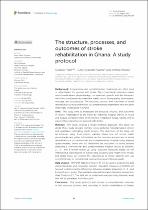| dc.contributor.author | Yarfi, Cosmos | |
| dc.contributor.author | Nyante, Gifty Gyamah | |
| dc.contributor.author | Rhoda, Anthea | |
| dc.date.accessioned | 2022-10-04T09:58:45Z | |
| dc.date.available | 2022-10-04T09:58:45Z | |
| dc.date.issued | 2022 | |
| dc.identifier.citation | Yarfi, C. et al. (2022). The structure, processes, and outcomes of stroke rehabilitation in Ghana: A study protocol. Frontiers in Neurology, 13, 947289. https://doi.org/10.3389/fneur.2022.947289 | en_US |
| dc.identifier.issn | 1664-2295 | |
| dc.identifier.uri | https://doi.org/10.3389/fneur.2022.947289 | |
| dc.identifier.uri | http://hdl.handle.net/10566/8005 | |
| dc.description.abstract | Conventional and complementary treatments are often used
in rehabilitation for persons with stroke. The conventional treatment makes
use of medications, physiotherapy, occupational, speech, and diet therapies,
while the complementary treatment makes use of homeopathy, naturopathy,
massage, and acupuncture. The structure, process, and outcomes of stroke
rehabilitation using conventional or complementary treatments have not been
empirically investigated in Ghana. This study aims to investigate the structure, process, and outcomes
of stroke rehabilitation at the Korle Bu Teaching Hospital (KBTH) in Accra
and Kwayisi Christian Herbal Clinic (KCHC) in Nankese-Ayisaa, Ghana, and to
explore the experiences of persons with stroke. | en_US |
| dc.language.iso | en | en_US |
| dc.publisher | Frontiers Media | en_US |
| dc.subject | Stroke | en_US |
| dc.subject | Rehabilitation | en_US |
| dc.subject | World Health Organization (WHO) | en_US |
| dc.subject | Ghana | en_US |
| dc.subject | Speech therapy | en_US |
| dc.title | The structure, processes, and outcomes of stroke rehabilitation in Ghana: A study protocol | en_US |
| dc.type | Article | en_US |

